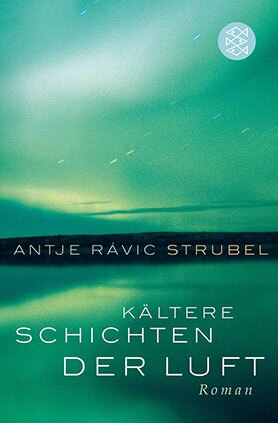Review
The plot is quickly summarized, and does not bode well. A group of East Germans, no longer young, runs a youth camp every summer in the forests of Sweden. One of them is Anja, demoralized by life in her East German town, insisting on her outsider role and suffering from it. An unsettlingly beautiful stranger named Siri foists herself upon her and gains her trust. To the group’s disapproval, an unconventional romance develops, in the course of which Anja experiences herself as a “boy”; the jealous Ralf turns rapist and ends up lying on the ground at the two women’s feet, killed by accident or on purpose.
East German drop-outs fleeing into the so-called wilderness only to encounter the conflicts they are trying to escape; a bunch of thirty-somethings at summer camp, albeit as counselors and managers, making up for romantic conflicts they’ve missed and gambling with gender identities; a vacation paradise tainted by mobbing, theft and blackmail, until nearly everything ends in madness, murder and mayhem. That could be the stuff of a trite tale about trite characters – characters like Ralf, who tries in vain to conceal the fact that he was a GDR border guard, or Sabine, whose forced westernization expresses itself in equally forced Anglicisms, or the lesbian narrator herself. These are figures that could easily have become clichés.
The risks this novel takes are great, and the aplomb with which they are mastered is all the greater. A closer examination reveals that what seems to be happening is not happening at all. What begins as trashy literature proves to be a sophisticated and profoundly unsettling feat of linguistic magic, beginning with the setting itself. This Sweden does not merely provide “a faux natural, regulated landscape” – strictly speaking, it is not even Sweden. As the only fixed borders in this story are there to be dissolved, this landscape, amphibious in the first place, segues into Norway, in the middle of the lake the characters are aswim in. The elfin Siri seems to have sprung full-fledged out of a neo-romantic story, and yet she is a highly artificial creation.
Her very name is invented by the narrator before our eyes, as if reading invisible writing. Is she supposed to be called “Siri” or the other way around, “Iris”? The reversibility of the name, these four iridescent letters, encapsulates the theme of this story: the question of identity, biography, the power of naming – and the possibility that everything, at any time, can be read the other way around.
The narrator herself acquires a new name the very first time she talks with the stranger: “Schmoll”, an amusing fancy that becomes a touch uncanny through single-minded repetition, just as the two women’s love is not entirely of this world. “You are a smart boy,” she says to the narrator. We do not see the body belonging to the narrator’s voice until she looks in the mirror: a young woman in jeans and a blouse, “unisex”, a casual word, but a big one. Anja knows who she is. And now this stranger, soft and tenacious as flowing water, undermines not only her resistance, but her unloved identity.
The narrator’s age changes along with her gender: when the thirty-year-old Anja becomes Schmoll, she is just fourteen, and sex is a discovery she has yet to make. When she sees her mirror image for the second time, a hundred pages later, the contours of her self have long since begun to dissolve: “I looked at myself, myself or the boy, we didn’t know who this smile belonged to, it changed me.” The uncanniest word in this sentence is the “we” – the speaker is alone.
Those are only hints, possibilities in an increasingly open-ended puzzle. The slow-motion dissolution of the antitheses that provide orientation, the gradual disappearance of terra firma becomes an adventure for the reader. Could it be that not merely Siri’s name is invented, that she herself is nothing but an optical illusion, a hallucination of the narrator? But then whom can we trust? Sometimes the riddle seems over-orchestrated and the mystery verges on mystification. But that does not detract from the charm of a book that is as intelligent as it is suggestive, constantly thematizing language itself. Even the act of love is above all a linguistic event: as if only the “body captured in words” truly finds itself.
In the cool brilliance of Antje Rávic Strubel’s linguistic art, abysses open up in the most banal objects. This is how the narrator sees the camp’s sports field: “The field gleamed. It lay there as if beneath a coat of oil. It was a surface that never tore, that always closed again as soon as a body had plunged into it. I tried not to panic.” The panic of disappearance is countered by the precise evocation of an androgynous, twilight happiness that can never be grasped. “On the border between shadow and light there was always a band of water vapor, it rose from the reed-covered ground, drew back before me and dispersed.” The narrow border strip of shadow and light: not merely the background of the story, it is its secret hero. “About light, they knew everything,” are the first words of the book. “They knew it in every shade.”
Whether everyone here really knows everything about light, is beyond the point. The narrator knows it. In every scene, at every moment she is conscious of it, making it enter and exit the stage like an actor, like a numinous power. It lies shimmering on the corrugated tin roof, pale behind the pines, froths up the sky or imprints itself upon the water; in this light figures appear “cut sharply into the morning”.
In impressionist paintings, things are not simply present, but created by the light itself, its fleeting materializations. Similarly, the scenarios and characters of this novel seem like the effects of an intangible and constantly shifting light, another Nordic cliché which the author reinterprets in virtuoso fashion. Whatever is to be seen here, it is the actions and sufferings of this light. Until at the end, in the colder layers of the air, it dissolves into an inescapable grey.
© F.A.Z. 2007
Translated by Isabel Fargo Cole


